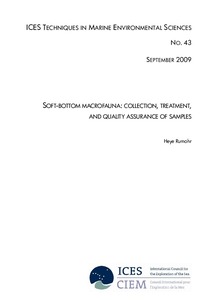| dc.contributor.author | Rumohr, Heye | |
| dc.date.accessioned | 2019-01-15T13:02:00Z | |
| dc.date.available | 2019-01-15T13:02:00Z | |
| dc.date.issued | 2009 | |
| dc.identifier.citation | Rumohr, H. (2009) Soft‐bottom macrofauna: collection, treatment, and quality assurance of samples. ICES Techniques in Marine Environmental Sciences, No. 43, 20pp. DOI: http://dx.doi.org/10.25607/OBP-238 | en_US |
| dc.identifier.issn | 0903–2606 | |
| dc.identifier.uri | http://hdl.handle.net/11329/681 | |
| dc.identifier.uri | http://dx.doi.org/10.25607/OBP-238 | |
| dc.description.abstract | These recommendations are intended to standardize the methods for benthos surveys used by different scientists to increase the comparability of results for different areas.
The results of ICES/HELCOM Quality Assurance workshops, intercalibrations, and ring tests have been incorporated into this set of recommendations to increase the quality, reliability and, therefore, comparability of benthos data before their final evaluation and storage in public databanks. These recommendations are timely, given the increasing number of researchers and institutions that are engaged in sorting and analysing benthos samples. This document covers all steps, from the design of the sampling programme, to considerations of which gear to use, as well as all shipboard methods, such as sampling with grabs, corers, dredges, and trawls. There is no single, standard sampling gear for benthos investigations. The choice of an appropriate sampler depends on the average living depth of the infauna of interest; this depth can range from the uppermost millimetre down to almost 1 m. When analysing the results, possible discrepancies between the penetration depth of the sampler and the actual living depth of the organisms must be considered. The choice of a suitable sampler is a compromise between specific sampling characteristics in different sediment regimes in the area to be sampled, good handling characteristics at sea in bad weather conditions, suitability for various ships, financial limitations, tradition, and scientific questions posed. Criteria for the rejection of samples are identified. Treatment of samples is described in detail, including sieving, transferring of the sample to the sample vessel, fixation, staining, and labelling. Laboratory procedures for sorting, taxonomic identification, and biomass determination are described. A list of items for in‐house quality assurance is included, as well as details for a warp‐rigged van Veen grab. | en_US |
| dc.language.iso | en | en_US |
| dc.publisher | International Council for the Exploration of the Sea (ICES) | en_US |
| dc.relation.ispartofseries | ICES Techniques in Marine Environmental Sciences; 43 | |
| dc.title | Soft-bottom macrofauna: collection, treatment, and quality assurance of samples. | en_US |
| dc.type | Report | en_US |
| dc.description.status | Published | en_US |
| dc.format.pages | 20pp. | en_US |
| dc.description.refereed | Refereed | en_US |
| dc.publisher.place | Copenhagen, Denmark | en_US |
| dc.description.currentstatus | Current | en_US |
| dc.description.eov | Benthic invertebrate abundance and distribution | |
| dc.description.bptype | Standard Operating Procedure | en_US |
| dc.description.bptype | Guide | en_US |
| obps.contact.contactemail | info@ices.dk | |
| obps.resourceurl.publisher | http://ices.dk/publications/library/ | en_US |
 Repository of community practices in Ocean Research, Applications and Data/Information Management
Repository of community practices in Ocean Research, Applications and Data/Information Management
